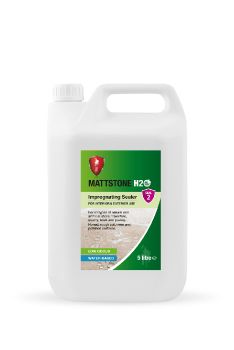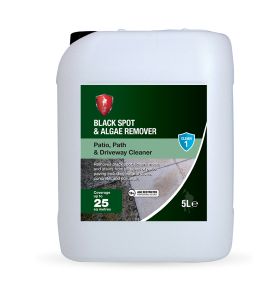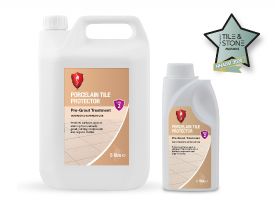
Outside areas are becoming increasingly important, yet maintenance regimes for patios, paths and terraces are rarely considered. But the popularity of seamless inside-to-outside floor finishes - and the new breed of water-based treatments - are slowly changing this.
When the same material is used internally and externally, it doesn’t take long for the two areas to contrast. This is particularly evident in stone installations, where flush surfaces are continued through bi-fold doors. Generally, the indoor slabs are sealed and the outdoor surface isn’t, so it very quickly becomes darker, and dirtier. One reason for a reluctance to seal outdoor stone is that traditional spirit-based products – often considered the only viable option – can only be applied when a surface is bone dry. However, high quality water-based or ‘acrylic’ sealers are now equal to and often superior to their solvent-based equivalents.
Water-based sealers won’t wash away!
Once applied and cured, water and spirit-based sealers actually function in a similar way. They’re both tough, durable and provide stain protection. Spirit and water-based solvents are simply used to facilitate application. Once a surface has dried, the spirit evaporates into the air and releases VOCs into the atmosphere, so they don’t actually contribute to a treatment’s ongoing performance. Water-based treatments enter a stone’s porosity in the same way but as they tend to be VOC-free they don’t have the same negative impact.
As well as offering high performance, with low VOC’s and low odour, quality water-based sealers – like LTP Mattstone H2O - can be applied over residual moisture, making outdoor treatment far more feasible year-round. They are also fully transparent to UV light, so they won’t undergo the photochemical breakdown experienced by some more UV-absorbent solvent-based sealers; this UV resistance can lead to extended longevity and protection, especially when used outdoors. Easier handling and storage are also big bonuses and, as a general rule, water-based sealers tend to go further than solvent-based sealers, with a typical extra coverage of between 10% and 20% on most surfaces.

A quality water-based sealer will offer protection against the elements, from frost, lichen and algae, plants and leaf matter, and BBQ spillages. It’s also worth mentioning that sealing, as opposed to not sealing, provides its own environmental advantages. The main one being that a sealed surface requires much less cleaning. This, in turn, reduces associated waste and water consumption and eliminates the need for more drastic intervention with harsh chemicals.
Refurbishing stone slabs
Existing stone patios and terraces will also greatly benefit from a protective seal. Before any treatment can be applied, the surface should be thoroughly cleaned; any residue that’s left in place will become sandwiched between the slab and the sealer, preventing the treatment from being absorbed into the stone’s porosity. Choose a patio cleaner like new LTP Blackspot & Algae Remover, to restore appearance before the surface is sealed and help prevent regrowth.

Porcelain patios need protecting too
Matt porcelain has become incredibly popular outdoors and it doesn’t need to be sealed – but it can be susceptible to staining during installation. The main issues relate to residues. When using a brush-in jointing compound, it’s very important to keep the surface of these tiles as wet as possible, so that any residue can be easily wiped away. Porcelain tiles can dry out quite quickly, causing an element of the resin within the compound to cling to the surface.

Whilst keeping the surface wetter for longer helps to improve and increase the working time of grouts and jointing compounds - and greatly reduces the possibility of grout and resin staining - problems can still arise. Dried on jointing compound can be difficult to remove and the residue left can ruin an installation. The textured nature of most external porcelains also makes it more difficult to apply grouts and jointing compounds. To prevent these issues, we recommend LTP’s Porcelain Tile Protector - a water-based ‘pre-and-post-grout’ treatment. The protector creates a barrier against stains and will help increase the working time of the grout and jointing compound. A barrier treatment will also make ongoing maintenance easier, as it will offer protection against dirt, moss and algae which can also quickly accumulate in textured natural-effect pavers.
Keeping surfaces shipshape
To help maintain a seamless aesthetic, fallen leaves should be swept up on a regular basis. Sycamores are a particular menace; aphids that live on the surface of the leaves excrete a sugary substance that provides a food source for algae. The combined sugar and bacteria leaves a telltale black spot stain and sometimes whole leaf prints on unsealed surfaces.
To clean slabs and remove slippery residue, choose a patio cleaner with a viscous formula to prevent run-off; once again, LTP’s Blackspot & Algae remover is a highly effective option. Treatment will also help prevent regrowth, saving time and money in the long-run.
For more advice and information about LTP’s range, please visit http://www.ltp-online.co.uk, tel. 01823 666213 or email [email protected]



